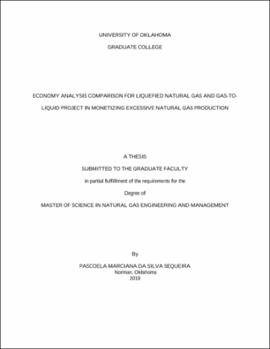| dc.description.abstract | Natural gas price has plummeted due to shale gas production booming which causes excessive capacity. Therefore, countries such as the U.S., Australia, Indonesia, Malaysia, and others with high natural gas production are searching for practical and profitable ways of transporting and utilizing natural gas. There are five major technologies used in the transportation of natural gas namely: pipelines, Liquefied Natural Gas (LNG), Gas-to-Liquid (GTL), Compressed Natural Gas (CNG), and Gas-to-Wire (GTW) or power generation. In this thesis, the economic metrics evaluations are performed in comparing LNG to GTL. These economic metrics are Net Present Value (NPV), Internal Rate of Return (IRR), Profitability Index (PI), and Payback Period.
A Monte Carlo simulation approach is used to evaluate economic metrics on various parameters such as feed gas price, plant capacity, carbon, and thermal efficiency, capital expenditure (CAPEX), operational expenditure (OPEX), products prices, transportations, tax rate, and discount rate. Sensitivity analysis shows NPV, IRR, PI and payback period for LNG are most affected by CAPEX, products selling price, Feed gas price, and efficiency of the plant, in respective order. For GTL project, the most affected parameters are product price, thermal efficiency, and CAPEX.
A low, base and high case scenario for each parameter is used in evaluating the economic metrics. Based on these case scenarios and parameters show that the LNG project is profitable and attractive when a plant capacity is 4.25 MTPA. In contrast, the GTL project is more profitable and attractive for a small-scale plant. In other words, depending on the natural gas reserves volume LNG plant option might be more attractive than GTL or vice versa. A small-scale GTL project appears to be a good option for an excessive natural gas production like Bakken Field where the average flaring gas is 527 MMcfd. A large-scale LNG plant would be a better option for Timor-Leste where the volume of natural gas reserves in Greater-Sunrise field is approximately 9.5 Tcf. These comparisons are done for best-case-scenario where the CAPEX and feed gas price are low and product price is medium to high.
The best and profitable case-scenario for LNG project is when the CAPEX is US$1,500/TPA, the product price should be higher than US$13/MMBtu, and feed gas price should be lower than US$2.80/Mcf. This best-case-scenario yields profitable economic metrics, but the optimal option is to have LNG plant with a capacity of 4.25 MTPA. Above 4.25 MTPA, the IRR is low and below that capacity, the IRR is remained flat as 4.25 MTPA.
Additionally, best-case-scenario for GTL is when CAPEX is lower than US$45,000/bpd and product price is higher than US$156/bbl. Even though this is the best-case-scenario but a large capacity of GTL project such as 50,000 bpd for Bakken Field yields an unprofitable economic metrics. However, this best-case-scenario does generate a profitable and attractive result for smaller-scale GTL plant capacity of 500 to 1,000 bpd.
In conclusion, the best option for Bakken field is to build several 1,000 bpd GTL plants in parallel to minimize the natural gas flaring in North Dakota. On the other hand, the best option to develop Greater Sunrise field is to build 4.25 MTPA LNG plant and additional numbers of GTL plants with a capacity of 1,000 bpd. This option yields NPV of US$9.3 Million, 9.4 percent IRR, 1.2 PI, and 6.7 years of the payback period. In addition, the 1,000 bpd GTL plant yields US$238 Million of NPV, 14 percent IRR, 1.7 PI, and 5.5 years of the payback period for each GTL plant. | en_US |

